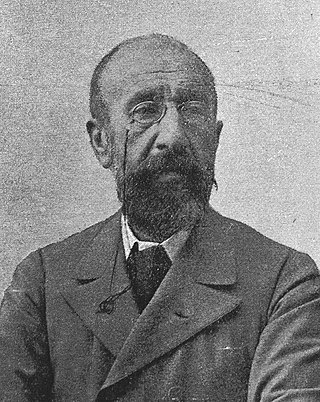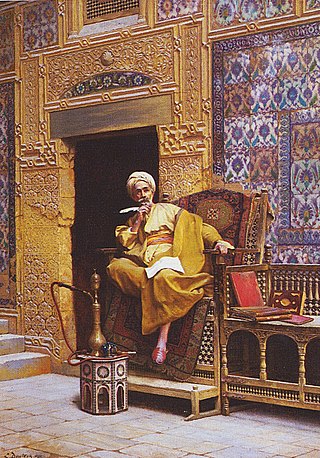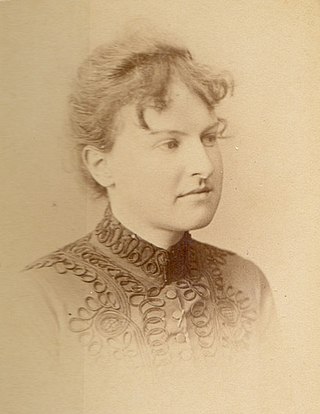
Edwin Austin Abbey was an American muralist, illustrator, and painter. He flourished at the beginning of what is now referred to as the "golden age" of illustration, and is best known for his drawings and paintings of Shakespearean and Victorian subjects, as well as for his painting of Edward VII's coronation. His most famous set of murals, The Quest and Achievement of the Holy Grail, adorns the Boston Public Library.

John William Waterhouse was an English painter known for working first in the Academic style and for then embracing the Pre-Raphaelite Brotherhood's style and subject matter. His paintings are known for their depictions of women from both ancient Greek mythology and Arthurian legend. A high proportion depict a single young and beautiful woman in a historical costume and setting, though there are some ventures into Orientalist painting and genre painting, still mostly featuring women.

Jean-Léon Gérôme was a French painter and sculptor in the style now known as academicism. His paintings were so widely reproduced that he was "arguably the world's most famous living artist by 1880." The range of his works includes historical paintings, Greek mythology, Orientalism, portraits, and other subjects. He is considered one of the most important painters from the academic period. He was also a teacher with a long list of students.

Mahadaji Shinde, later known as Mahadji Scindia or Madhava Rao Scindia, was a Maratha statesman and general who served as the Maharaja of Gwalior from 1768 to 1794. He was the fifth and the youngest son of Ranoji Rao Scindia, the founder of the Scindia dynasty. He is reputed for having restored the Maratha rule over North India and for modernizing his army.

Osman Hamdi Bey was an Ottoman administrator, intellectual, art expert and also a prominent and pioneering painter. He was the Ottoman Empire's first modern archaeologist, and is regarded as the founding father of both archaeology and the museum curator's professions in Turkey. He was the founder of Istanbul Archaeology Museums and of the Istanbul Academy of Fine Arts known today as the Mimar Sinan Fine Arts University. He was also the first mayor of Kadıköy.

Jean-Joseph Benjamin-Constant, born Jean-Joseph Constant, was a French painter and etcher best known for his Oriental subjects and portraits.

Théodore Jacques Ralli or Theodorus Rallis was an ethnic Greek painter, watercolourist and draughtsman, who spent most of his working life in France and Egypt.

Henry Bacon was an American painter, author, illustrator, and translator. Before his formal training as an artist, he served as a soldier and war artist during the American Civil War, and was badly wounded in the Second Battle of Bull Run. He then studied in France, and became a member of the Pont-Aven School, painting genre subjects of French country life, many sold back in America. He first traveled to Egypt in 1897, and then developed an interest in Orientalist painting, soon spending his winters in the Middle East, dying in Cairo.

Shinde Chhatri at Wanawadi in Pune, India is a memorial dedicated to the 18th century Maratha military leader Mahadji Shinde who served as the commander-in-chief of the Maratha army under the Peshwas from 1760 to 1780. It is one of the most significant landmarks in the city and is reminiscent of the Maratha rule. It is a hall that marks the spot of Mahadji Shinde's cremation on 12 February 1794.

Alfred Smith (1854–1932) was a French artist from Bordeaux who painted in the Impressionist, Post-Impressionism and Fauvist style. Some of his works resemble the early works of Claude Monet.

Ludwig Deutsch was a French painter of Austrian origin, who settled in Paris and became a noted Orientalist artist. Having studied at the Vienna Academy of Fine Arts from 1872 to 1875, he moved to Paris in 1878, where he became associated with other Orientalist painters. Most of his works were painted in his studio in Paris, but he had visited Egypt on several journeys from 1885 to 1898. In 1919, he became a French citizen and started to write his name as Louis Deutsch.

Simon Agopian or Simon Hagopian at times Simon Agopyan was a prominent Ottoman Armenian landscape and portrait painter.

Gyula Tornai was a Hungarian painter, now featured in the Hungarian National Gallery. He was a noted painter in the Orientalist genre.

Fernand Lungren (1857–1932) was an American painter and illustrator. He is mostly known for his paintings of American South Western landscapes and scenes as well as for his earlier New York and European city street scenes.

Anna Huntington Stanley was an American Impressionist artist.

Alberto Pasini was an Italian painter. He is best known for depicting Orientalist subjects in a late-Romantic style.
Emma Cheves Wilkins (1870–1956) was an American painter who played a major role in the art scene in Savannah, Georgia during the early twentieth century. Her works can be found in the permanent collections of Armstrong State University in Savannah, the Morris Museum of Art in Augusta, the Telfair Museum of Art in Savannah, and in private collections.

Baiza Bai was one of the wives of Daulat Rao Scindia, the ruler of Gwalior princely state in India, and served as regent after his death.

Frederic Salmon Growse was a British civil servant of the Indian Civil Service (ICS), Hindi scholar, archaeologist and collector, who served in Mainpuri, Mathura, Bulandshahr and Fatehpur during British rule in India.


































